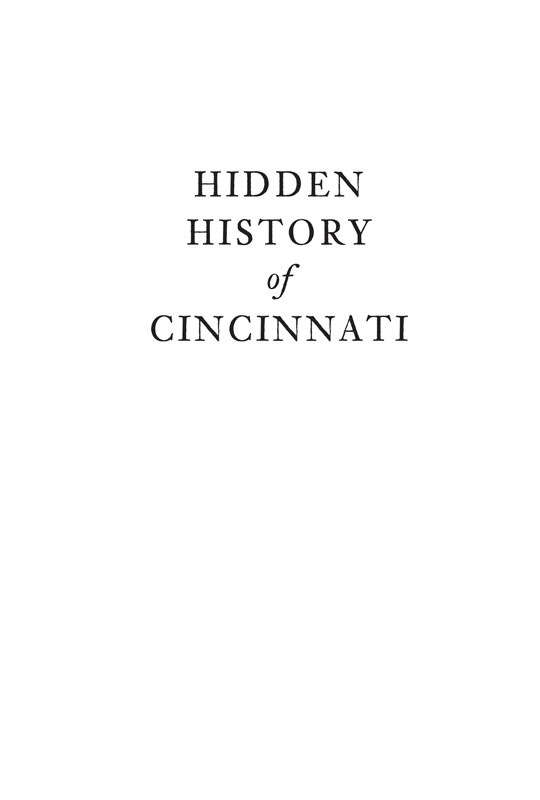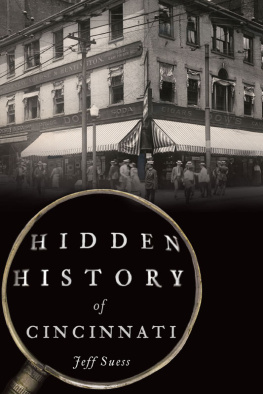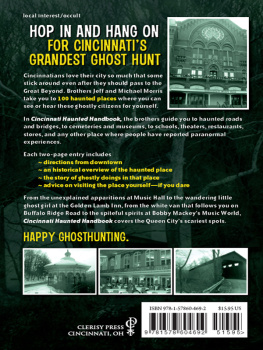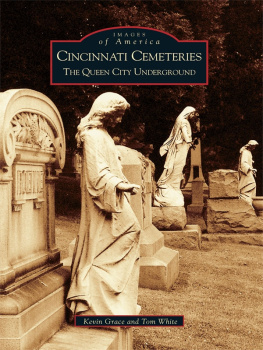Jeff Suess - Hidden History of Cincinnati
Here you can read online Jeff Suess - Hidden History of Cincinnati full text of the book (entire story) in english for free. Download pdf and epub, get meaning, cover and reviews about this ebook. year: 2016, publisher: Arcadia Publishing, genre: Non-fiction. Description of the work, (preface) as well as reviews are available. Best literature library LitArk.com created for fans of good reading and offers a wide selection of genres:
Romance novel
Science fiction
Adventure
Detective
Science
History
Home and family
Prose
Art
Politics
Computer
Non-fiction
Religion
Business
Children
Humor
Choose a favorite category and find really read worthwhile books. Enjoy immersion in the world of imagination, feel the emotions of the characters or learn something new for yourself, make an fascinating discovery.
- Book:Hidden History of Cincinnati
- Author:
- Publisher:Arcadia Publishing
- Genre:
- Year:2016
- Rating:4 / 5
- Favourites:Add to favourites
- Your mark:
- 80
- 1
- 2
- 3
- 4
- 5
Hidden History of Cincinnati: summary, description and annotation
We offer to read an annotation, description, summary or preface (depends on what the author of the book "Hidden History of Cincinnati" wrote himself). If you haven't found the necessary information about the book — write in the comments, we will try to find it.
Hidden History of Cincinnati — read online for free the complete book (whole text) full work
Below is the text of the book, divided by pages. System saving the place of the last page read, allows you to conveniently read the book "Hidden History of Cincinnati" online for free, without having to search again every time where you left off. Put a bookmark, and you can go to the page where you finished reading at any time.
Font size:
Interval:
Bookmark:



Published by The History Press
Charleston, SC
www.historypress.net
Copyright 2016 by Jeff Suess
All rights reserved
Portions of the text appeared previously in the Cincinnati Enquirer.
Front cover: courtesy of the Cincinnati Enquirer/Lawrence J. Neumann.
First published 2016
e-book edition 2016
ISBN: 978.1.62585.775.0
Library of Congress Control Number: 2016942428
print edition ISBN 978.1.46711.989.4
Notice: The information in this book is true and complete to the best of our knowledge. It is offered without guarantee on the part of the author or The History Press. The author and The History Press disclaim all liability in connection with the use of this book.
All rights reserved. No part of this book may be reproduced or transmitted in any form whatsoever without prior written permission from the publisher except in the case of brief quotations embodied in critical articles and reviews.
To Mom and Dadwith love.

CONTENTS
ACKNOWLEDGEMENTS
History projects are collaborations built on the meticulous work and great care of those historians and researchers who came before; of the librarians who index and save; of the reporters and photographers who witnessed and recorded; and, lastly, of the men and women who lived our history. None of this would be possible without any of you. You have my sincere gratitude.
Many thanks to my editor, Krista Slavicek, and the folks at The History Press; to Rick Green and Peter Bhatia at the Cincinnati Enquirer; to my friends and family for their love and support; to Luann Gibbs and Debbie Radel for invaluable research; to Bonnie Speeg for sharing Mary Janes story; to Angie Lipscomb, the Enquirer and staff, Kevin Grace, Lily Birkhimer and Ohio History Connection, and Diane Mallstrom and the Public Library of Cincinnati and Hamilton County for the use of photographs; to Tina Wyeth Baker, E.R. Bellinger, Lisa Gillespie, Dic Gross, Michael B. Gunn, Anna K. Heran, Jennifer Koehler, Tamera Lenz Muente, Brian Powers, William F. Romain, Jim Schaffer, Christopher Smith, Corky Steiner, William Styple, Jeremy Suess and Jeff Wyeth for their help; to Harry Pence, Roscoe Eads, Fred Morgener, Ray Zwick, Sally Besten and Frank Harmon; and to my beloved Kristin and Dashiell, you make it all worthwhile.
INTRODUCTION
What exactly is hidden history? Certainly there are things we can never know, facts lost to time. Much more has been recorded than we may realize, and we can trace our history if we dig deep enough and know where to look. Yet, history can also be buried and forgotten, or purposely erased, or just never noticed. There is some of all that in here. Someone can be famous one day, a faded memory the next. Or they may not fit the narrative of history. We may not recognize the extraordinary in the ordinary until some time has passed. Then we need somethinga historical marker, a blog post, a bookto spark our curiosity to know more.
There are hundreds of such stories in Cincinnatis history. Here are some that deserve more attentionpeople and events that should be revealed, honored and remembered. These are stories of bravery, fortitude, ambition and tragedy; of humor, whimsy, conflict and creation. They belong to Cincinnati but also reach beyond the city, touching on baseball and toys, on celebrities, on civil war and on hardy pioneers. At the heart, these are stories of real peopleand a few birdswho are worth knowing. I cant wait to introduce you.
PART I
EARLY DAYS

Cincinnati in 1802 was a small town on the western frontier. The placement of Fort Washington (at rear right) helped establish Cincinnati as the dominant settlement in the West. Courtesy of the Cincinnati Enquirer archives.
THE SERPENT MOUND
The history of a region typically begins at the recorded events. In the case of Cincinnati, thats what was chronicled by European settlers starting in the eighteenth century. Earlier events are relegated to study by archaeologists, anthropologists and geologists. But, really, it is all history. The study of what transpired before the first white men trekked to the area, and even those early days of settlement, lead to new discoveries that help us solve the mysteries of the past.
In geological terms, the Cincinnati topography was formed over eons by the invasions of three glaciers. Two million years ago, in the Pleistocene epoch known as the ice age, the land where Cincinnati sits was flat, with a meandering north-flowing river that geologists call the Teays River. The Kansan glacier advanced from the north 1.2 million years ago, stopping at northern Kentucky before retreating. The ice sheet created a great lake that, over hundreds of thousands of years, eroded a deep valley about one hundred feet lower than the Ohio River today. Two more glaciers, the Illinoian (400,000 years ago) and the Wisconsinan (70,000 years ago), left deposits within the deep valley, creating shelves of rock and clay that formed the regions hills and the basin in which Cincinnati was settled. The melted ice forged the west-flowing Ohio River.
Spear points as much as 12,000 years old indicate that the earliest occupants in Hamilton County were Paleo-Indians. But three later native cultures were the predominant settlers in the area. The Adena people lived in southern Ohio from 800 BC to AD 100, during the Early Woodland period. They were noted for burying their dead in mounds left as territory markers. The Hopewell, also mound builders, followed from 100 BC to AD 400. They had an interest in geometry and astronomy, evident in their earthworks. The Fort Ancient culture occupied the area from AD 1000 to 1650.
Indian mounds are concrete evidence of the ancient peoples who would have roamed the same grounds that Cincinnati lies on today. There were several Adena burial mounds in what is now Hamilton County, from Sayler Park to Indian Hill, though most have been obscured or erased by development. Elliptical burial mounds were identified throughout the Cincinnati basin, from Fifth Street to Liberty, by early Cincinnatians Daniel Drake, William Henry Harrison and Robert Clarke. But there was no real attempt to preserve the mounds as the city grew on top of them. Drake described the largest mound in the center of the city in 1815:
It is a very broad ellipsis; one diameter extending 800 feet east from Race-street; and the other about 660 feet south from Fifth-street.On the east side it had an opening nearly 90 feet in width. It is composed of loam, and exhibits, upon being excavated, quite a homogenous appearance. Its height is scarcely three feet, upon a base of more than thirty. There is no ditch on either side. Within the wall, the surface of the ground is somewhat uneven or waving; but nothing is found that indicates manual labor.
The most prominent and intriguing prehistoric earthwork in the region is the Serpent Mound, located about seventy miles east of Cincinnati in neighboring Adams County. No one knows who built the effigy mound, perhaps the worlds largest, or when. Archaeologists studying the site have theorized based on available evidence, but even the authorities are not in agreement.
Font size:
Interval:
Bookmark:
Similar books «Hidden History of Cincinnati»
Look at similar books to Hidden History of Cincinnati. We have selected literature similar in name and meaning in the hope of providing readers with more options to find new, interesting, not yet read works.
Discussion, reviews of the book Hidden History of Cincinnati and just readers' own opinions. Leave your comments, write what you think about the work, its meaning or the main characters. Specify what exactly you liked and what you didn't like, and why you think so.










